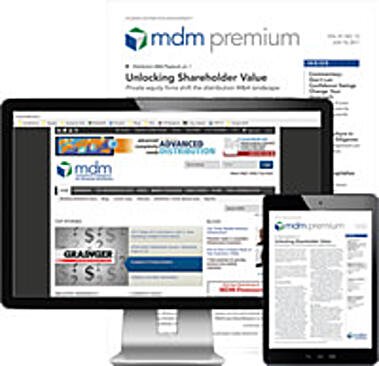
Harnessing the power of data can transform a distributor. This article introduces distributors to the benefits of analytics, including how data-informed decisions can help a company analyze market potential, profile customers and better target prospects — all of which can grow revenue, reduce costs and improve profitability.
Data has never been more accessible, nor has it ever been more critical to a distributor’s success, but simply obtaining data is just a starting point. How the data is used and analyzed will ultimately determine the impact it will have on your business — and the impact can be significant for any company that wants to improve their top and bottom lines.

Even the best and most accurate data can be misused, so it’s critical to have a savvy data analyst in place to harness the potential of your data. Through thoughtful analytics, your data can be transformed into information, uncovering a path that leads to operational efficiencies and profitability.
Why wouldn’t a distributor deploy analytics in their business? Companies opt against using it for a variety of reasons — they think it’s too expensive, they aren’t sure how effective it will be or they have gone without for the lifetime of their company and don’t see why they should begin now.
But, as you’ll see in this article, the distributors who are putting a premium on robust analytics-backed processes and strategies are best poised to navigate today’s increasingly complex competitive landscapes and take market share in the process.
What Analytics Can Do for Your Business
Simply put, analytics can do a lot, and there’s a good chance that your business is already using some form of analytics to maintain and enhance the level of service your customers have come to expect.
Through reporting solutions, distributors can analyze a myriad of things to increase their value proposition to the markets they serve. Whether you’re using the data from your inventory management system to better organize your fulfillment centers or compiling the data from your e-commerce systems to better understand your customers’ digital buying behaviors, analytics can give you an in-depth view of nearly every aspect of your business.
Your analytics outcomes are directly related to the data available and the quality of said data. As mentioned, your company is likely already using analytics to better understand your business reporting out of your ERP system, which is referred to as Descriptive Analytics.
According to the introduction of MDM’s 2015 book, Distributor’s Guide to Analytics, “Descriptive analytics is what most distributors live and breathe – ERP exports, Excel analysis, dashboards to slightly deeper comparative tools that give visibility into what the data say happened or is happening.”
Here are a few examples of descriptive analytics and the benefits they offer a distributor:
- Sales Reporting: This can lead to increased sales and improved margins.
- Customer Reporting: This can uncover buying behaviors, including what products are being bought and at what frequency.
- Vendor Reporting: This can lead to efficient buying strategies.
- Product & Inventory Reporting: This can lead to efficient inventory and materials management strategies.
Possessing the above analytical capabilities is critical because they enable distributors to have an in-depth understanding of all the activities and processes taking place within their physical and digital locations. But these reports require more than just sorting of numbers in a spreadsheet. Both quantitative and qualitative expertise is critical for harnessing the true power of your data, so analytics-based solutions require more than a mere spreadsheet technician.
The Critical Role of a Data Analyst
Analytics is a team sport, and, like any athletics squad taking the field or court, a company’s analytics department requires an array of perspectives and skills. The good news is you don’t have to be a data guru to participate. In my experience, the best reporting solutions have come about when both business and data experts unite to create meaningful outputs. These outputs generate actionable insights that produce bottom-line profitability.
For example, your data analyst might not know all the processes and associated costs to fulfill an order once received. This information is critical if you are trying to analyze the cost to serve your customers, so someone from the fulfillment team will need to provide some insights.
Also, even the most talented data analysts may struggle to create value out of their data if they are not well informed of the business and processes creating the data. In this case, your company’s subject matter expert (SME) should be actively engaging with your data analyst.
Because it takes a coordinated and collaborative effort, the next time your team has a strategic planning session or is discussing your next initiative, invite your colleagues in the data department. Allow them to understand your processes, terminologies and pain points. Whether it’s sharing the meaning behind the many acronyms and processes your teams use daily or walking them through a new project or sales initiative, keeping your resident data analyst up to speed is time well spent. They, in turn, will be able to collect data from other areas of the company and compile it into something that benefits everyone.
Over time, your resident data analyst will become an extension of your team, but remember that cultivating a data-driven, cross-functional organization is a journey. And regardless of where you are in that journey, it’s imperative to get in the game and extract the value of your data by bringing previously unknown insights to the forefront of your decision-making processes.
Taking your Analytics to the Next Step
No matter where a company is in the analytics journey, they want to sell more products to both new and existing customers. The below illustration can help identify the types of analytics you are currently doing and what steps you can take to propel your analytics capabilities to the next level.

Many distributors find themselves in the bottom left quadrant of the graphic. Likely, you’re already reporting against your transactional data to find what products your current customers are buying and what products they are not. Described as Whitespace Reporting, this can be used to inform your sales teams with the right information to win over new product sales against your current customers.
For instance, the Whitespace report may identify a customer who regularly buys fuses but not the accompanying fuse holders and accessories. This gives your sales professional a point of conversation on their next call to better understand why the customer isn’t buying fuse holders, for example, and how they can potentially win additional product sales.
Distributors in the bottom right quadrant are targeting new customers but are typically limited to their local market knowledge and expertise. They often prospect for new customers through the traditional means of cold calling or leveraging industry relationships to expand market share.
The goal is to elevate the business into a market prospecting approach. As you scroll up to the top two quadrants, you will see that bolstering your analytics toolbox with additional market data sources can supercharge your reporting capabilities. This will deepen and expand your focus by identifying new customers, products and territories to target.
One example: Your current reporting may show you are selling X amount of safety products in a given territory, but what it may not be telling you is the total demand for safety products in that territory. By connecting your existing data to a trusted market data set you can quickly understand how your business compares to the overall market, giving you actionable information for your sales and marketing teams to better target new and existing customers to gain market share.
To optimize the use of your new data, it’s critical to accurately connect your transactional data to the market data. Common data points that distributors use to connect their data are as follows:
- NAICS: North American Industry Classification System
- SIC: Standard Industrial Classification
- DUNS (Dun & Bradstreet)
- Geographical: Customer Address Info
Next Steps
This is only an overview of how analytics can help your company target new customers and markets, which, in turn, will lead to a stronger top and bottom line. More details can be found in the aforementioned book from MDM, Distributor’s Guide to Analytics.
Another valuable resource is MDM Analytics — a sister company of Modern Distribution Management — where we regularly work with clients to utilize both internal and external data to improve strategic planning, optimize sales programs, perform research and analysis of market conditions and connect a company’s transactional data and our trusted market data to determine end-user demand by product and industry segments throughout North America.
When trying to understand the competitive and complex landscape that any distributor is navigating, trusted external market data is the most important place to start. MDM Analytics can help you identify your blind spots and uncover missed opportunities in your market.
It is common practice for us to dive into how you categorize your product and customer data to create accurate and meaningful connections, bringing relevant market data to the forefront of your analytics. Our Market Prospector tool facilitates customized searches by product, industry segment and geography to deliver market insight and ideal sales targets.
If you don’t have your customer data defined in your system to your liking, MDM Analytics can help. We’ve worked with it all, and we have the capabilities to enhance your customer data, appending Dun & Bradstreet firmographic information and predicted spend to ensure that you have the best data available to better understand your customers.
Whether you are just now diving into the world of analytics or are well on your way into this important journey, you can’t afford to dismiss the power of bringing your data to life. Ask us about the industry’s best kept secret, Market Prospector, an analytics tool 30 years in the making and trusted by the top 25% of wholesalers in the US.
While the best time to have deployed analytics in your business might have been 10 years ago, the second-best time is now. I’d be happy to connect with you to discuss how MDM Analytics can uncover missed opportunities in your market.
About the Author: Donnie Williamson is Analytics Manager for MDM Analytics. Learn more about how MDM Analytics can help your company by calling 888-742-5060 or emailing analytics@mdm.com.

